
* In the prewar era, the Japanese Nakajima aircraft company built a series of biplane and monoplane fighters for the Imperial Japanese Navy and Army -- the work leading in refinement to the "Ki-27", the standard Army fighter up to the start of the Pacific War, and then the "Ki-43 Hayabusa", which was the standard Army fighter during the conflict. This document gives a history and description of early Nakajima fighters, the Ki-27, and the Ki-43.
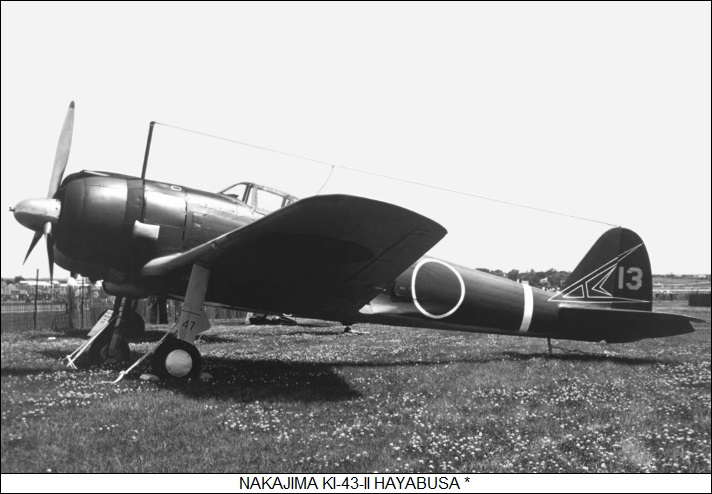
* The Nakajima aircraft company of Japan got started in the single-engine fighter business by contracting with the British Gloster company in 1926 for the design of a naval carrier-based fighter, with Gloster calling the design the "Gambet". Nakajima also obtained a production license; the British company would never produce the design itself, though not surprisingly it was similar to fighters that Gloster did produce, such as the Gamecock.
The Nakajima-built Gambet was obtained from 1929 by the Imperial Japanese Navy (IJN) as the "Type 3 Carrier Fighter". It was of wood & cloth construction, being armed with twin 7.7-millimeter (0.303-caliber) machine guns -- presumably the Type 89, a Vickers copy -- in troughs on the sides, and powered by a Bristol Jupiter VI nine-cylinder air-cooled radial with 315 kW (420 HP) -- also built under license by Nakajima.
The Type 3 had an empty weight of 912 kilograms, a wingspan of 9.69 meters (31 feet 10 inches), a length of 6.47 meters (21 feet 4 inches), and a top speed of 245 KPH (152 MPH / 132 KT). About 50 of the initial "A1N1" variant were obtained; they were followed by about 100 of the "A1N2" variant, with a Nakajima Kotobuki Ko engine, based on the Jupiter VI and Pratt & Whitney (P&W) Wasp, providing 335 kW (450 HP). The last Type 3 machines were delivered in 1932, seeing combat in China in the early 1930s.
After examining samples of Boeing-built naval biplane fighters obtained by the IJN, Nakajima developed an improved biplane fighter, which was accepted by the IJN in 1932 as the "Type 90 Carrier Fighter". It had a metal airframe with cloth covering, and an uprated Kotobuki Otsu radial engine providing 430 kW (580 HP) -- enclosed in a Townend ring cowl, as opposed to the bare cylinders of the Type 3 fighter. Armament remained twin 7.7-millimeter machine guns. The Type 90 had an empty weight about 15% greater than the Type 3, and was about 20% faster. About 100 Type 90s were built to 1936, in three variants:
In addition, 66 "A3N1" two-seat trainers were manufactured, production ending in 1939.
In the meantime, Nakajima worked on a single-engine two-seat biplane fighter prototype for the IJN, the "Nakajima Akegawa Fighter (NAF) 1". It was configurationally similar to the Type 90, if about 20% heavier again, having a metal frame with fabric covering, plus a Kotobuki Otsu engine in a Townend ring. It differed noticeably in having a rear cockpit, with a third 7.7-millimeter machine gun on a flexible mount. Following the loss of that machine in a crash in 1933, Nakajima went on to build two prototypes of the improved "NAF-2". The NAF-2 met IJN specs, but the service decided that single-engine two-seat fighters weren't a good idea, and the NAF-2 never entered production -- the NAF-2 prototypes being sold off to the ASAHI SHIMBUN newspaper.
The IJN did obtain a redesigned follow-on to the Type 90, the "Type 95 Carrier Fighter". It was configurationally similar to the Type 90, with a Nakajima Hikari Ko radial engine providing 545 kW (730 HP) and twin 7.7-millimeter machine guns. 221 were obtained from 1936 to 1940 as the "A4N1". It was the last biplane carrier fighter in IJN service, and the last carrier fighter built by Nakajima. It was obsolescent when introduced, and ended up being used mostly for training, though it did see some action in China.
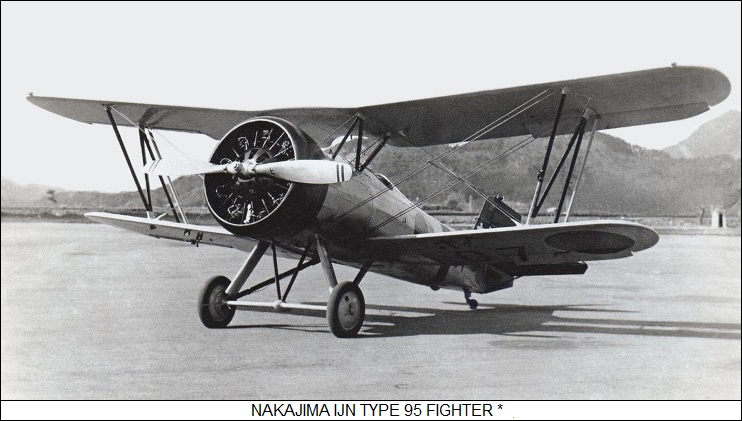
* Nakajima had much more of a future in building single-engine fighters for the Imperial Japanese Army (IJA). In 1927, working in collaboration with two engineers loaned from the French Dewoitine aircraft company, Nakajima engineers began work on a single-seat fighter for an IJA requirement. Two prototypes of the "NC" fighter were flown in 1928, being of high-winged monoplane "parasol" configuration, featuring a metal fuselage of monocoque construction; a metal-framed wing with fabric covering; a Jupiter VI radial engine; and armament of twin 7.7-millimeter machine guns.
Feedback from the IJA was negative, and the requirement was canceled anyway. However, Nakajima built five more NC prototypes on company funds to 1931; the last two were substantially redesigned, only retaining the rear fuselage of the earlier prototypes. That configuration was accepted by the IJA as the "Type 91". It featured a Bristol Jupiter VII radial engine, with 390 kW (520 HP), in a Townend ring, and had armament of twin 7.7-millimeter machine guns.
___________________________________________________________________
NAKAJIMA TYPE 91 FIGHTER:
___________________________________________________________________
wingspan:
11 meters (36 feet 1 inch)
wing area:
20 sq_meters (215.3 sq_feet)
length:
7.26 meters (23 feet 10 inches)
height:
2.79 meters (9 feet 2 inches)
empty weight:
1,075 kilograms (2,370 pounds)
loaded weight:
1,530 kilograms (3,375 pounds)
max speed at altitude:
300 KPH (185 MPH / 160 KT)
service ceiling:
9,000 meters (29,500 feet)
endurance:
2 hours
___________________________________________________________________
A total of 340 Type 91s was built by Nakajima from 1931 into 1934, with Ishikawajima building a hundred more. Nakajima also built 23 "Type 91-2" machines in 1934, featuring the Kotobuki Otsu engine, and also flew a modified Type 91 as the "7-Shi" carrier-based fighter for an IJN competition -- which Nakajima lost. The Type 91 remained in IJA service until 1937.
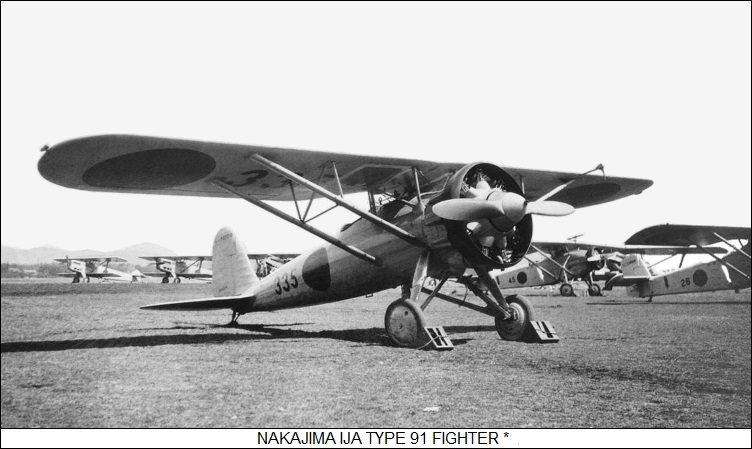
* Following up the NAF two-seat fighter designs, in 1934 and 1935 Nakajima built five prototypes of a refined two-seat fighter, the "Ki-8". It was of all-metal construction, being a low-wing aircraft with spatted taildragger landing gear. It was powered by a Nakajima Kotobuki Hei radial with 530 kW (710 HP); armament was twin 7.7-millimeter machine guns fixed firing forward, plus one on a flexible mount in the rear cockpit. IJA evaluation revealed a number of deficiencies; they proved correctable, but then the IJA decided a two-seat fighter wasn't a good idea, either.
Nonetheless, the Ki-8 was a useful experiment. Nakajima then developed a state-of-the-art monoplane fighter in response to a 1935 requirement, with an eye to service with both the IJN and the IJA. The "Ki-11", as it was designated, was configurationally similar to the Boeing P-26 Peashooter fighter, being a low-wing fighter with spatted main landing gear and an open cockpit -- the landing gear being wire-braced to the wings, the wings being wire-braced to the fuselage.
The Ki-11 was of mixed construction, with the fuselage, wing center section, and landing gear made in aircraft aluminum alloy, while the wings and tail surfaces were made of wood and canvas. It was powered by a Nakajima Kotobuki Otsu engine, with service machines to be armed with twin 7.7-millimeter machine guns. Four prototypes were built; it was rejected in favor of the Kawasaki Ki-10 biplane fighter, the IJA preferring maneuverability over speed. The fourth Ki-11 prototype, which differed from the others by having an enclosed instead of open cockpit, was sold to ASAHI SHINBUN.
Following the Ki-11, Nakajima investigated a particularly innovative new fighter design, the "Ki-12", which was developed with assistance from Dewoitine engineers, and owed much to the Dewoitine D.510 fighter. It had a vee-12 engine, as opposed to the radials much preferred by the Japanese, in the form of a Hispano-Suiza 12Xcrs V engine with 455 kW (610 HP); and it was also fitted with fully retractable landing gear, making it one of the first Japanese aircraft with that feature. It was to be armed with twin 7.7-millimeter machine guns, plus a 20-millimeter cannon firing from between the engine cylinders.
The Ki-12 was leading-edge in speed, range, and firepower, but it wasn't notably maneuverable, and the IJA also judged it too big and complicated. The Ki-12 ended up effectively being a technology demonstrator.
BACK_TO_TOP* In June 1935, the IJA issued a requirement for an advanced low-wing monoplane to replace the Kawasaki Ki-10 (IJA Type 95) biplane fighter, with the new fighter to have significantly improved performance. Nakajima, Kawasaki, and Mitsubishi all submitted designs, and were asked to build two prototypes each.
Nakajima had already been working on a monoplane fighter design, the "PE", developed by a team under Koyama Yasushi, evolved from the unproduced Ki-11, with technical influence from the Ki-12. One PE was rolled out in July 1936, to be used as the basis for the two prototypes of the "Ki-27". The first Ki-27 prototype performed its initial flight on 15 October 1936, being followed in December by the second. The second prototype was similar to the first, except for a larger wing. They were both powered by a Nakajima Kotobuki Otsu, driving a two-blade variable-pitch propeller.
Although not quite the match of the two competitors in speed and climb rate, the Ki-27 was more maneuverable; both the IJA and IJN were biased towards agility, and so the Ki-27 won the award. The Army ordered 10 pre-production machines for evaluation, with these machines delivered through 1937. The evaluation went well, with series production authorized at the end of 1937 as the "Army Type 97 Fighter Model Ko".
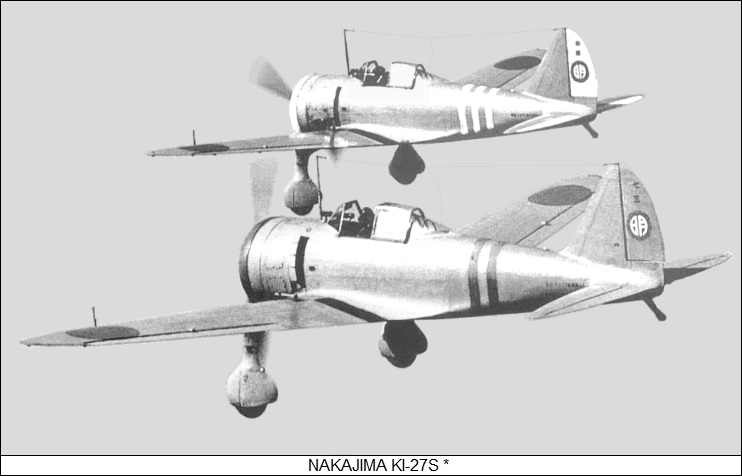
As with the Ki-11, the Ki-27 was a low-wing all-metal monoplane with a radial engine, and spatted taildragger landing gear with a tailskid. It had wings with a straight leading edge and a tapered trailing edge, a scheme that would be retained in later Nakajima fighters; the wings were enlarged again from those of the second prototype. Production machines featured the Nakajima Kotobuki Hei radial. Armament was twin 7.7-millimeter machine guns, aimed by a telescopic sight. The pre-production machines introduced an enclosed cockpit, as opposed to the open cockpit of the prototype, with the canopy design refined in production aircraft. It was a big technical step forward for IJA aviation.
___________________________________________________________________
NAKAJIMA KI-27:
___________________________________________________________________
wingspan:
11.31 meters (37 feet 1 inch)
wing area:
18.56 sq_meters (200 sq_feet)
length:
7.53 meters (24 feet 8 inches)
height:
3.25 meters (10 feet 8 inches)
empty weight:
1,110 kilograms (2,445 pounds)
normal loaded weight:
1,790 kilograms (3,945 pounds)
max speed at altitude:
470 KPH (290 MPH / 255 KT)
service ceiling:
12,150 meters (32,950 feet)
normal range:
625 kilometers (390 MI / 340 NMI)
___________________________________________________________________
The Ki-27 went into combat service over northern China in March 1938. It was well superior to the opposition, which was not saying a great deal, until the Chinese began to fly the faster Soviet-made Polikarpov I-16 -- a "flying barrel" with a big radial engine, low wing, retractable landing gear, and performance more comparable to the Ki-27. As manufacturing ramped up, the "Ki-27 Otsu" was introduced, featuring:
In the 1939 border clash with the Soviets at Khalkin Gol in Mongolia, the Ki-27 did well at first, being generally superior to Soviet Polikarpov I-15 biplanes and holding its own against the I-16. However, the VVS -- Red Air Force -- then obtained improved I-16s, with uprated engines and better performance, plus armor and twin 20-millimeter cannon. Although the I-16 still was slower overall than the Ki-27, the I-16 could escape in a dive, and Red pilots learned to make hit-&-run attacks, diving on Ki-27s and then escaping -- avoiding turning fights that the Ki-27 was likely to win.
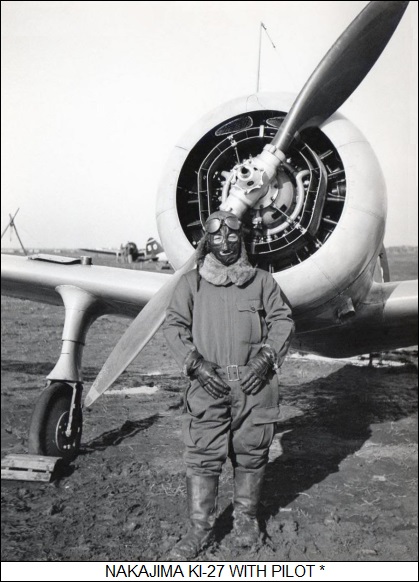
The weaknesses of the Ki-27 then became apparent: its armament of twin 7.7-millimeter machine guns was too light, and worse it lacked armor and self-sealing fuel tanks, such features having been sacrificed in the name of performance. It could neither dish out punishment nor take it. The Japanese, however, had an insecure refusal to admit inferiority, and claimed they shot down 1,340 Soviet aircraft in the clash -- which was six times acknowledged Soviet losses, and three times the number of Soviet aircraft in the theater. The Soviets claimed 215 kills -- when the IJA only had 200 aircraft in the theater -- while the Japanese admitted to 120 losses.
By the end of 1940, production of the Ki-27 had been transferred to the Manchurian Aircraft Company in Harbin, which continued to turn out the type into 1942. Work was done on a lightened version of the Ki-27, the "Ki-27-KAI", as insurance against failure of the next-generation Nakajima Ki-43 fighter -- see below -- with two prototypes built, but it never entered service, and the Ki-27-KAI was abandoned. After the Japanese offensive in the Pacific began in December 1941, the Ki-27 served in support of the rapid conquest of Western colonial possessions in Asia, serving as a bomber escort in actions in Malaya, Singapore, Netherlands East Indies, Burma, and the Philippines. It also fought against the American Volunteer Group (AVG / "Flying Tigers") in China, where it fared poorly against the sturdier and better-armed, if not as agile, Curtiss P-40 Warhawk.
Stiffening resistance showed the Ki-27 wasn't up to dealing with increasingly formidable Western fighters, but by the time that became obvious, the improved Ki-43 was available. The Ki-27 relegated to training, as the "Ki-97 Fighter Trainer", with the spats removed and a tailwheel instead of a tailskid. The Ki-27 was also provided to the Manchukuo puppet state and Thai armed forces, seeing combat with both.
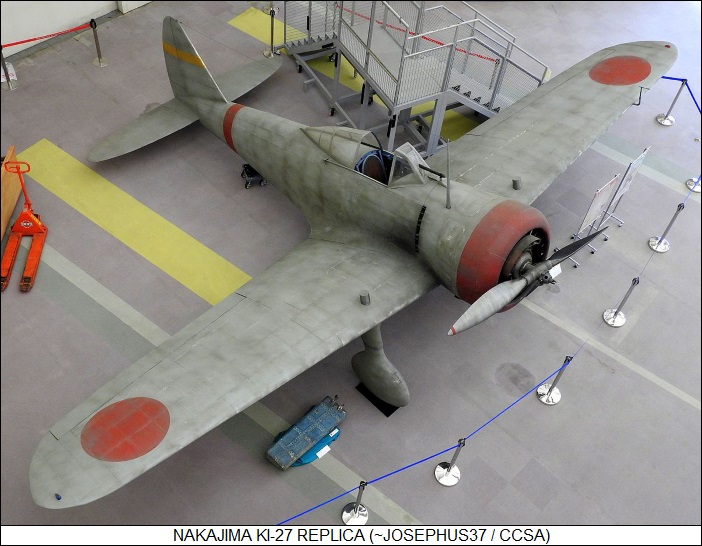
The Ki-27 was thrown back into combat in the last desperate months of the war, being used as a kamikaze aircraft, carrying 500 kilograms (1,100 pounds) of explosives. It was also forced into use for air defense, where it suffered terribly at the hands of modern American fighter aircraft. A total of 3,399 Ki-27s, including prototypes, was built, including 1,379 by the Manchurian Aircraft Company in Harbin. Following the war, the Ki-27 saw limited combat with both Nationalist and Communist Chinese forces.
BACK_TO_TOP* Even as the Ki-27 was entering service, the IJA was pursuing an improved successor. Having been impressed by the Ki-27, the IJA did not conduct a competition, simply issuing a specification to Nakajima in December 1937 to initiate development. The specification was ambitious, calling for a maximum speed of 500 KPH (310 MPH), a range of 800 kilometers (500 miles), and agility comparable to or better than that of the Ki-27.
The design effort was under the direction of Itokawa Hideo, who would later become famous as a pioneer of Japanese rocketry. The initial prototype of the "Ki-43" performed its first flight in January 1939, with a second prototype following in February, and a third in March. Test pilot feedback was negative, the aircraft being described as less maneuverable than the Ki-27, and not much faster.
Nakajima engineers responded with ten evaluation machines featuring successive improvements -- such as a weight trim, a slimmer fuselage with the tail assembly moved back, and a new canopy. The last of them introduced maneuvering "butterfly" flaps that provided the type with enhanced agility. With these changes, the Ki-43 was ordered into production as the "Army Type 1 Fighter". It was given the name "Hayabusa (Peregrine Falcon)".
The initial production version was the "Ki-43-I Ko", which was delivered from mid-1941, with the Hayabusa quickly becoming the standard IJA fighter. The aircraft was fast, maneuverable, and had a high rate of climb. It was powered by a Nakajima Ha-25 Sakae 14-cylinder two-row air-cooled radial engine with 710 kW (950 HP), driving a two-bladed prop -- originally a fixed-pitch wooden propeller, quickly changed to a variable-pitch metal propeller.
Baseline armament was the traditional twin 7.7-millimeter Type 89 machine guns, fitted in front of the canopy, with distinctive flash suppressors. They were aimed with a telescopic sight. The Hayabusa featured taildragger landing gear, all gear assemblies having single wheels, the main gear pivoting in the inner wings to retract towards the fuselage -- there were no doors on the mainwheels -- and the tailwheel being fixed.
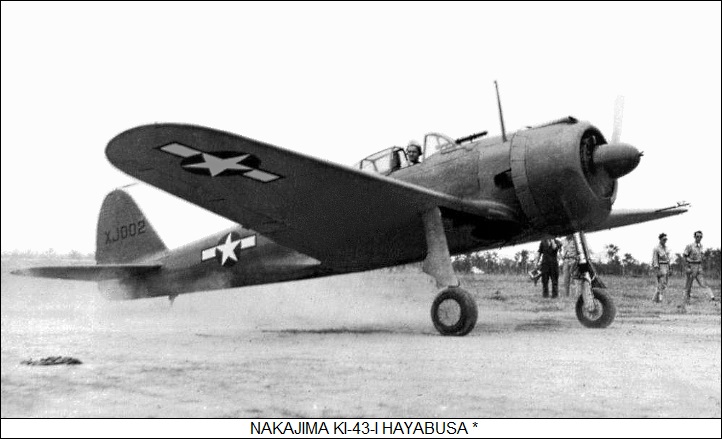
With the outbreak of war in the Pacific, the Ki-43 came as a nasty shock to the Allies, having generally better performance than the Allied fighter aircraft and extreme agility, with IJA pilots greatly enjoying its excellent handling. The Allies nicknamed it the "Army Zero", the Ki-43 being comparable in most respects to the IJN's Mitsubishi Zero fighter. However, combat experience showed the Ki-43 suffered from the same deficiencies as the Ki-27: it lacked and self-sealing fuel tanks, and the armament was too light -- The Ki-43 differing significantly from the Zero in being under-gunned. As a result, the Ki-43-I was followed by improved subvariants:
Five Ki-43-I machines were modified as prototypes for the improved "Ki-43-II" first flying flew in early 1942, with three pre-production machines following, and production of the "Ki-43-II Ko" beginning at the company's factory at Ota in the fall of 1942. Changes included:
Only a few Ki-43-II Ko machines were built, production moving on to the "Ki-43-II Otsu" -- much the same as the Ki-43-II Ko, the most significant changes being modifications in the engine installation.
___________________________________________________________________
NAKAJIMA KI-43-II OTSU HAYABUSA:
___________________________________________________________________
wingspan:
10.84 meters (35 feet 7 inches)
wing area:
21.4 sq_meters (230.4 sq_feet)
length:
8.92 meters (29 feet 3 inches)
height:
3.27 meters (10 feet 9 inches)
empty weight:
1,910 kilograms (4,211 pounds)
normal loaded weight:
2,590 kilograms (5,710 pounds)
MTO weight:
2,925 kilograms (6,450 pounds)
max speed at altitude:
530 KPH (330 MPH / 285 KT)
service ceiling:
11,200 meters (36,750 feet)
normal range:
1,760 kilometers (1,095 MI / 950 NMI)
___________________________________________________________________
Production lines for the Ki-43 were also established at the Tachikawa Aircraft Company, and the 1st Army Air Arsenal in Tachikawa. The 1st Army Air Arsenal, lacking adequate staff, only completed 49 Ki-43s before being forced to halt production.
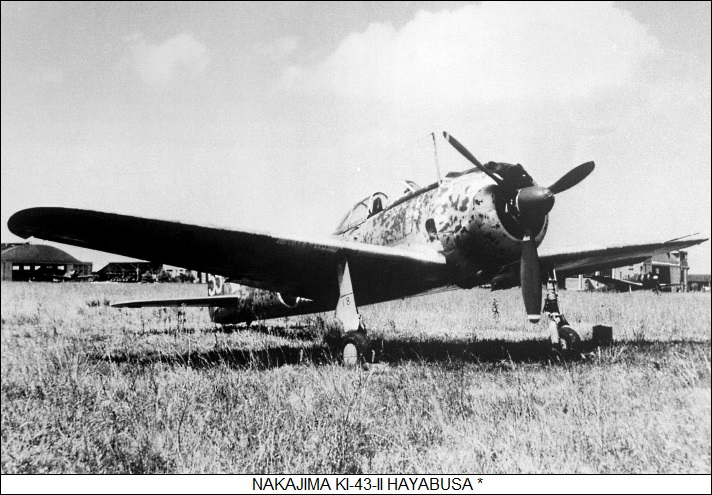
Following the Ki-43-II Otsu, Nakajima went on to gather up various changes in production into the "Ki-43-II KAI", which featured bomb racks moved outboard on the wings, to prevent bombs from hitting the prop in dive-bombing attacks; oil cooler moved to the center fuselage; individual instead of grouped exhausts, providing a bit of additional thrust; and minor alterations to the airframe to improve manufacturability.
Tachikawa went on to produce the "Ki-43-III-Ko", designed by Nakajima engineers, with Nakajima building ten prototypes. It was fitted with the uprated Nakajima Ha-115 Otsu engine with 920 kW (1,230 HP), the Ki-43-III entering service in mid-1943. Nakajima ended production of the Ki-43 in 1944, focusing on the much more formidable Ki-84 Hayate. Tachikawa continued to turn it out to the end of the conflict.
Tachikawa worked on a interceptor variant, the "Ki-43-III Otsu", powered by a Mitsubishi Kinsei Ha-112 14-cylinder two-row air-cooled radial engine with 970 kW (1,300 HP) -- plus armament of twin 20-millimeter Ho-5 cannon, which was more or less an up-gunned Browning M2. Two prototypes were built, which were still in test when the fighting stopped.
Total Ki-43 production amounted to 5,919 aircraft, including 3,239 by Nakajima, 2,631 by Tachikawa, and 49 by the Tachkawa Arsenal. It served on all fronts involving the IJA. The top-scoring Hayabusa pilot was Sergeant Anabuki Satoshi with 39 confirmed victories, almost all scored with the Ki-43. Many Ki-43s were used during the last months of the war for kamikaze missions against the American fleet.
During the war, some Ki-43s were supplied to Japanese-backed regimes of Thailand, Manchukuo, and the Chinese collaborationist government of Wang Jingwei as well. After the conflict, the French used captured Ki-43s in limited numbers against Viet Minh insurgents, while the Indonesian liberation government used abandoned Ki-43s against the Dutch colonialists.
BACK_TO_TOP* Japanese aircraft were assigned "reporting names" by the Allies during World War II, the Ki-27 being known as "Nate" -- or it seems "Abdul" early on -- and the Ki-43 being known as "Oscar". However, it is unclear if these names were in much use until relatively late in the conflict; German aircraft were also assigned reporting names, but such are rarely mentioned. Instead of trying to puzzle out the specifics, it is best just to mention the reporting names, and leave the matter at that.
Note that the designation suffixes "Ko", "Otsu", and "Hei" reflects a Chinese-derived list of the ten days of the Chinese week, and are known as the "heavenly stems". They are generally translated as "A", "B", and "C" respectively.
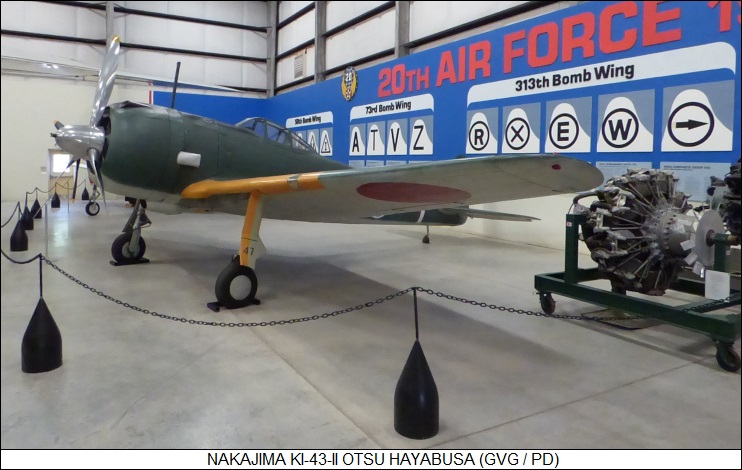
* Sources include:
* Revision history:
v1.0.0 / 01 sep 17 v1.0.1 / 01 aug 19 / Review & polish. v1.0.2 / 01 jun 21 / Review & polish. v1.0.3 / 01 may 23 / Review & polish. v1.0.5 / 01 may 25 / Review & polish. (+)BACK_TO_TOP
